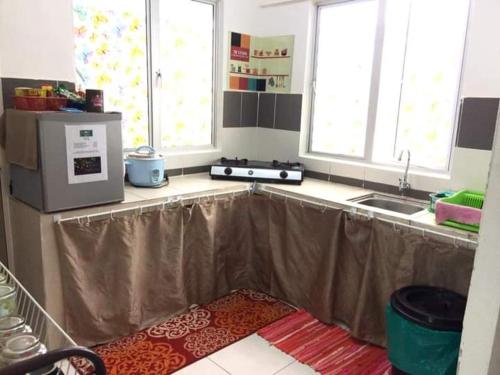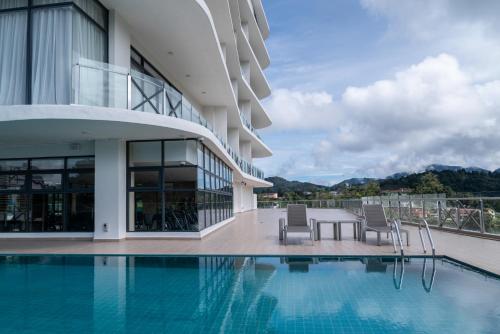Cameron Highlands, Malaysia
Sitting on the terrace of the Cameron Valley Tea House, looking out over the plantations below, I sip on an overpriced cup of tea.
At RM9 (US$2.20) for a small pot, it’s hardly outrageous – however, it’s certainly much more than it should cost in Malaysia. But visitors like me just suck up the price because what we’re really here for are the view and the experience.
And, sadly, that is the story of the Cameron Highlands these days. Stunning scenery – but at what cost?
I’m not just talking about the financial cost either. The bigger concern is the environmental damage that could end up destroying the place.
Arriving in the Cameron Highlands by bus from Kuala Lumpur, I’m struck straight away by the incredible landscapes. Rolling down the slopes are large tea plantations, the bushes arranged in a way that creates a textured carpet of green, with lines and patterns across it.
The plantations rise and fall on inclines and over hillocks, catching the light or emphasised by dark shadows. The vibrant colour of the bushes seems to glow.
I watch it all rush past me from the window and look forward to exploring the area properly the next day.
A lot of visitors come to the Cameron Highlands to explore. Although there are a fair few international tourists, most of the crowd is actually from other parts of Malaysia or neighbouring Singapore.
It is more than 1000 metres above sea level here (up to 2031 metres at the highest point) and so is much cooler than Kuala Lumpur or other cities. This is a nice respite from a humid life and so is particularly popular on weekends.
The increasing tourist numbers have meant a need for an increase in facilities. These come in two forms – buildings (like hotels) or farms (like tea plantations). For both, land is needed, and what is being cleared away are the native forests that have grown on the hills here for tens of thousands of years.
This land clearing may mean more income for the locals but it is causing a lot of problems for the environmental ecosystem, which is getting out of balance.
Without the roots of trees to strengthen the ground, landslides are becoming more common; less trees are leading to an increase in temperatures; more farms mean the rivers are disappearing; extra tourists are causing an explosion in pollution.
For a visitor like me, these environmental concerns are not obvious on first glance. I only find out about the issues by doing some research. But luckily my plan to explore the Cameron Highlands is a sustainable one.
I want to go hiking – to see a mixture of the native forests and the new tea plantations, and catch some of the mountain views.
I would recommend you do the same if you’re planning to visit the Cameron Highlands. There are public buses or taxis that you can catch between the different towns – but there’s only so much you can see from the road.
To really appreciate the area, you need to go by foot and get away from the developed areas.
The easiest town for accommodation is Tanah Rata and there’s where I stay for a couple of nights. I do two big hikes – one in the morning and one in the afternoon – and I would certainly recommend either (or both) to you. I have marked them on this map here.
Let me tell you a bit about each of them.
Morning hike: Sunrise and tea plantations
From Tanah Rata, you can wake up early and do a hike to the top of the nearby mountain, Gunung Jasar, in time for sunrise. It takes about an hour to get to the top from the middle of town, so I would suggest taking a torch because it will be quite dark at the start.
From the top of the mountain, I took a path that is not well-used and so was a bit tricky in parts (with some steep muddy downhills with a rope) and some section were it’s a bit overgrown. But it’s a great adventure and takes you down to the largest section of tea plantations near Tanah Rata.
Once you arrive, there are quite a few paths you can explore through the tea plantation, or you can follow the one on the map I did which will take you to the Cameron Valley Tea House where you can have some tea and breakfast.
From there, I walked back to Tanah Rata along the main road (not marked on the route on the map).
Afternoon hike: Mountains and forests
In the afternoon, I headed off in the opposite direction and did a large loop through the forests and up to the top of a mountain called Gunung Berembun.
The trek is about eight kilometres in total and took about three hours. One of the really nice things was seeing the native trees and animals.
You easily forget that you’re so close to the tourism development when you’re out in this part of the region, with very few other hikers along the path.
On the way back, you can swing by Parit Waterfall.
There are lots of other hiking trails in the Cameron Highlands and there are plenty of options if you’re looking for something different or extra trails.
For instance, the long hike to the top of Gunung Brinchang (the highest point of the region) could be worth tackling as a day trip.
I think you can do hiking independently but there are local tour operators you can organise a trip with, if you prefer.
These operators also offer other tours around the area to see some of the other tourist attractions like tea plantations and all sorts of farms – strawberries, flowers, lavender, butterfly, etc. I am a bit suspicious about some of these because they have only been established to cater to tourists.
It’s these ‘artificial’ farms and attractions that I think pose the biggest risk to the sustainability of the Cameron Highlands.
Not only are they clearing land to build them, but they are encouraging an environment where visitors need to see and do things, rather than just appreciate what is here.
The Cameron Highlands with its cool climate, native wilderness, beautiful views and collection of original early 20th century tea plantations should be enough. There’s no need for the self-destructive tea change we’re seeing at the moment.
THE BEST ACCOMMODATION IN THE CAMERON HIGHLANDS
I would recommend basing yourself in Tanah Rata, where there’s a good selection of accommodation and easy access to the region’s highlights.
BACKPACKER

Just 300 metres from the bus station, Sleepbox Hotel has a lovely outdoor terrace and a fun common area.
APARTMENT

Very affordable for its size, Sya Honey Homestay is a three-bedroom apartment with a great location, comfortable beds, and a lovely view.
BOUTIQUE

With large modern rooms, Hotel Bryton at Centrum has a convenient location within a mall complex.
LUXURY

As well as the great rooms, Zenith Cameron has an outdoor pool and a fantastic breakfast buffet.
These pictures are very mesmerizing and beautiful want to visit this place of Malaysia. Thanks for sharing this post I just loved it.
What a fabulous review! Very informative and your photos are so inspiring!! I love a good hike while on the go! Great experience of Cameron Highlands.
These photographs of tea garden are very captivating, they are very appealing and alluring. Malaysia also has some amazing places.
I simply love Cameron Highlands. It was a highlight of my trip to Malaysia!
I agree with a few points that you have made.
Cameron Highlands is indeed a gem, which hopefully, would remain with us and part of Malaysian tourism.
There have been landslides happening there recently, due to forest development and illegal plantation.
It is just my hope Cameron would remain a gem in our sphere…
Thanks for this informative post.I just enjoyed reading it.Pictures are also very beautiful .Hope I will visit Malaysia in coming time.
Superb blog and thanks for sharing such a great post.
This blog is not truthful. In reality the tea plantations are quite small. The trails are all in extremely bad shape, unmaintained and about 80% closed by the government.
If you come to the Cameron highlands to enjoy nature and hike, you’ll be disappointed.
Hiring the best stunning Uttarakhand tour package to enjoy an exciting adventure tour will refresh your mood and provide you with a memorable journey to Uttarakhand.
Amazing Blog! Thanks for sharing.